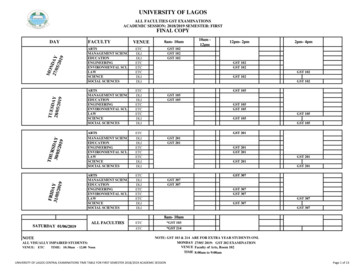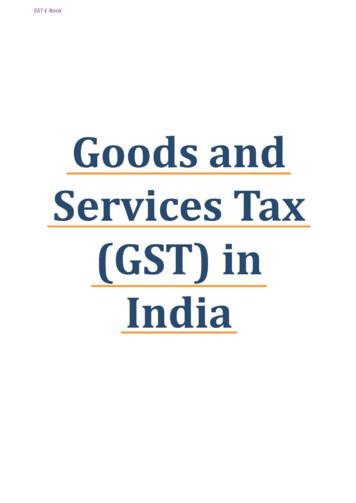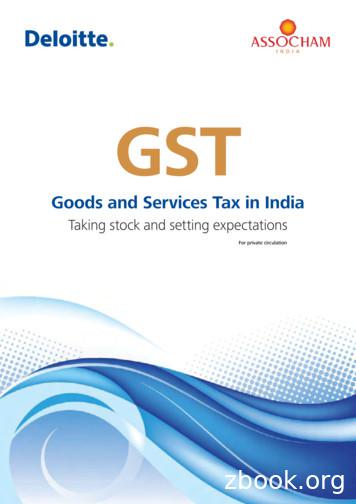GOODS AND SERVICE TAX (GST) CONCEPT & STATUS
GOODS AND SERVICE TAX (GST)CONCEPT & STATUSCENTRAL BOARD OF INDIRECT TAXES AND CUSTOMS (CBIC)DEPARTMENT OF REVENUEMINISTRY OF FINANCEGOVERNMENT OF INDIAAS ON 1st NOVEMBER, 20181 46
The uniform system of taxation, which, with a few exceptions of nogreat consequence, takes place in all the different parts of the UnitedKingdom of Great Britain, leaves the interior commerce of thecountry, the inland and coasting trade, almost entirely free. Theinland trade is almost perfectly free, and the greater part of goodsmay be carried from one end of the kingdom to the other, withoutrequiring any permit or let-pass, without being subject to question,visit, or examination from the revenue officers. This freedom ofinterior commerce, the effect of uniformity of the system of taxation, isperhaps one of the principal causes of the prosperity of Great Britain;every great country being necessarily the best and most extensivemarket for the greater part of the productions of its own industry. Ifthe same freedom, in consequence of the same uniformity, could beextended to Ireland and the plantations, both the grandeur of the stateand the prosperity of every part of the empire, would probably be stillgreater than at present”– Adam Smith in ‘Wealth of Nations’1. INTRODUCTION:Whether it was uniformity of taxation and consequent free interior trade orpossession of ‘the jewel in the crown’ at the root of prosperity of Britain isdebatable, nonetheless the words of father of modern economics on the benefitsof uniformity of system of taxation cannot be taken too lightly. Beforeimplementation of Goods and Service Tax (GST), Indian taxation system was afarrago of central, state and local area levies. By subsuming more than a score oftaxes under GST, road to a harmonized system of indirect tax has been pavedmaking India an economic union.2 46
2. CONSTITUTIONAL SCHEME OF INDIRECT TAXATION IN INDIABEFORE GST :2.1Article 265 of the Constitution of India provides that no tax shall be leviedor collected except by authority of law. As per Article 246 of the Constitution,Parliament has exclusive powers to make laws in respect of matters given inUnion List (List I of the Seventh Schedule) and State Government has theexclusive jurisdiction to legislate on the matters containing in State List (List II ofthe Seventh Schedule). In respect of the matters contained in Concurrent List (ListIII of the Seventh Schedule), both the Central Government and StateGovernments have concurrent powers to legislate.2.2Before advent of GST, the most important sources of indirect tax revenuefor the Union were customs duty (entry 83 of Union List), central excise duty(entry 84 of Union List), and service tax (entry 97 of Union List). Although entry92C was inserted in the Union List of the Seventh Schedule of the Constitution bythe Constitution (Eighty-eighth Amendment) Act, 2003 for levy of taxes onservices, it was not notified. So tax on services were continued to be levied underthe residual entry, i.e. entry 97, of the Union List till GST came into force. TheUnion also levied tax called Central Sales Tax (CST) on inter-State sale andpurchase of goods and on inter-State consignments of goods by virtue of entry92A and 92B respectively. CST however is assigned to the State of origin, as perCentral Sales Tax Act, 1956 made under Article 269 of the Constitution.2.3On the State side, the most important sources of tax revenue were tax onsale and purchase (entry 54 of the State List), excise duty on alcoholic liquors,opium and narcotics (entry 51 of the State List), Taxes on luxuries,entertainments, amusements, betting and gambling (entry 62 of the State List),octroi or entry tax (entry 52 of the State List) and electricity tax ((entry 53 of the3 46
State List). CST was also an important source of revenue though the same waslevied by the Union.3. HISTORICAL EVOLUTION OF INDIRECT TAXATION IN POSTINDEPENDENCE INDIA TILL GST:3.1In post-Independence period, central excise duty was levied on a fewcommodities which were in the nature of raw materials and intermediate inputs,and consumer goods were outside the net by and large. The first set of reform wassuggested by the Taxation Enquiry Commission (1953-54) under thechairmanship of Dr. John Matthai. The Commission recommended that sales taxshould be used specifically by the States as a source of revenue with Uniongovernments' intervention allowed generally only in case of inter-State sales. Italso recommended levy of a tax on inter-State sales subject to a ceiling of 1%,which the States would administer and also retain the revenue.3.2The power to levy tax on sale and purchase of goods in the course of inter-State trade and commerce was assigned to the Union by the Constitution (SixthAmendment) Act, 1956. By mid-1970s, central excise duty was extended to mostmanufactured goods. Central excise duty was levied on unit, called specific duty,and on value, called ad valorem duty. The number of rates was too many with nooffsetting of taxes paid on inputs leading to significant cascading andclassification disputes.3.3The Indirect Taxation Enquiry Committee constituted in 1976 under Shri LK Jha recommended, inter alia, converting specific rates into ad valorem rates,rate consolidation and input tax credit mechanism of value added tax atmanufacturing level (MANVAT). In 1986, the recommendation of the JhaCommittee on moving on to value added tax in manufacturing was partiallyimplemented. This was called modified value added tax (MODVAT). In principle,4 46
duty was payable on value addition but in the beginning it was limited to selectinputs and manufactured goods only with one-to-one correlation between inputand manufactured goods for eligibility to take input tax credit. The comprehensivecoverage of MODVAT was achieved by 1996-97.3.4The next wave of reform in indirect tax sphere came with the NewEconomic Policy of 1991. The Tax Reforms Committee under the chairmanshipof Prof. Raja J Chelliah was appointed in 1991. This Committee recommendedbroadening of the tax base by taxing services and pruning exemptions,consolidation and lowering of rates, extension of MODVAT on all inputsincluding capital goods. It suggested that reform of tax structure must have to beaccompanied by a reform of tax administration, if complete benefits were to bederived from the tax reforms. Many of the recommendations of the ChelliahCommittee were implemented. In 1999-2000, tax rates were merged in three rates,with additional rates on a few luxury goods. In 2000-01, three rates were mergedinto one rate called Central Value Added Tax (CENVAT). A few commoditieswere subjected to special excise duty.3.5Taxation of services by the Union was introduced in 1994 bringing in itsambit only three services, namely general insurance, telecommunication and stockbroking. Gradually, more and more services were brought into the fold. Over thenext decade, more and more services were brought under the tax net. In 1994, taxrate on three services was 5% which gradually increased and in 2017 it was 15%(including cess). Before 2012, services were taxed under a ‘positive list’approach. This approach was prone to ‘tax avoidance’. In 2012 budget, negativelist approach was adopted where 17 services were out of taxation net and all otherservices were subject to tax. In 2004, the input tax credit scheme for CENVATand Service Tax was merged to permit cross utilization of credits across these5 46
taxes.3.6Before state level VAT was introduced by States in the first half of the firstdecade of this century, sales tax was levied in States since independence. Sales taxwas plagued by some serious flaws. It was levied by States in an uncoordinatedmanner the consequences of which were different rates of sales tax on differentcommodities in different States. Rates of sales tax were more than ten in someStates and these varied for the same commodity in different States. Inter-statesales were subjected to levy of Central Sales Tax. As this tax was appropriated bythe exporting State credit was not allowed by the dealer in the importing State.This resulted into exportation of tax from richer to poorer states and alsocascading of taxes. Interestingly, States had power of taxation over services fromthe very beginning. States levied tax on advertisements, luxuries, entertainments,amusements, betting and gambling.3.7A report, titled "Reform of Domestic Trade Taxes in India", on reformingindirect taxes, especially State sales tax, by National Institute of Public Financeand Policy under the leadership of Dr. Amaresh Bagchi, was prepared in 1994.This Report prepared the ground for implementation of VAT in States. Some ofthe key recommendations were; replacing sales tax by VAT by moving over to amultistage system of taxation; allowing input tax credits for all inputs, includingon machinery and equipment; harmonization and rationalization of tax ratesacross States with two or three rates within specified bands; pruning ofexemptions and concessions except for a basic threshold limit and items likeunprocessed food; zero rating of exports, inter-State sales and consignmenttransfers to registered dealers; taxing inter-State sales to non-registered persons aslocal sales; modernization of tax administration, computerization of operationsand simplification of forms and procedures.6 46
3.8The first preliminary discussion on transition from sales tax regime to VATregime took place in a meeting of Chief Ministers convened by the Union FinanceMinister in 1995. A standing Committee of State Finance Ministers wasconstituted, as a result of meeting of the Union Finance Ministers and ChiefMinisters in November, 1999, to deliberate on the design of VAT which was latermade the Empowered Committee of State Finance Ministers (EC). Haryana wasthe first State to implement VAT, in 2003. In 2005, VAT was implemented inmost of the states. Uttar Pradesh was the last State to implement VAT, from 1stJanuary, 2008.4. INTERNATIONAL PERSPECTIVES ON GST / VAT:4.1VAT and GST are used inter-changeably as the latter denotescomprehensiveness of VAT by coverage of goods and services. France was thefirst country to implement VAT, in 1954. Presently, more than 160 countries haveimplemented GST / VAT in some form or the other. The most popular form ofVAT is where taxes paid on inputs are allowed to be adjusted in the liability at theoutput. The VAT or GST regime in practice varies from one country to another interms of its technical aspects like ‘definition of supply’, ‘extent of coverage ofgoods and services’, ‘treatment of exemptions and zero rating’ etc. However, at abroader level, it has one common principle, it is a destination based consumptiontax. From economic point of view, VAT is considered to be a superior system oversales tax of taxing consumption because the former is neutral in allocation ofresources as it taxes value addition. Besides, there are certain distinct advantagesof VAT. It is less cascading making the taxation system transparent and antiinflationary. From revenue point of view, VAT leads to greater compliancebecause of creation of transaction trails.7 46
4.2When compared globally, VAT structures are either overly centralizedwhere tax is levied and administered by the Central government (Germany,Switzerland, Austria), or dual GST structure wherein both Centre and Statesadminister tax independently (Canada) or with some co-ordination between thenational and sub-national entities (Brazil, Russia). While a centralized structurereduces fiscal autonomy for the States, a decentralized structure enhancescompliance burden for the taxpayers. Canada is a federal country with uniquemodel of taxation in which certain provinces have joined federal GST and othershave not. Provinces which administer their taxes separately are called ‘nonparticipating provinces’, whereas provinces which have teamed up with the FederalGovernment for tax administration are called ‘participating provinces’.4.3The rate of GST varies across countries. While Malaysia has a lower rate of6% (Malaysia though scrapped GST in 2018 due to popular uproar against it),Hungary has one of the highest rate of 27%. Australia levies GST at the rate of10% whereas Canada has multiple rate slabs. The average rate of VAT across theEU is around 19.5%.5. NEED FOR GST IN INDIA:5.1The introduction of CENVAT removed to a great extent cascading burdenby expanding the coverage of credit for all inputs, including capital goods.CENVAT scheme later also allowed credit of services and the basket of inputs,capital goods and input services could be used for payment of both central exciseduty and service tax. Similarly, the introduction of VAT in the States has removedthe cascading effect by giving set-off for tax paid on inputs as well as tax paid onprevious purchases and has again been an improvement over the previous sales taxregime.8 46
5.2But both the CENVAT and the State VAT have certain incompleteness. Theincompleteness in CENVAT is that it has yet not been extended to include chain ofvalue addition in the distributive trade below the stage of production. Similarly, inthe State-level VAT, CENVAT load on the goods has not yet been removed andthe cascading effect of that part of tax burden has remained unrelieved. Moreover,there are several taxes in the States, such as, Luxury Tax, Entertainment Tax, etc.which have still not been subsumed in the VAT. Further, there has also not beenany integration of VAT on goods with tax on services at the State level withremoval of cascading effect of service tax.5.3CST was another source of distortion in terms of its cascading nature. It wasalso against one of the basic principles of consumption taxes that tax should accrueto the jurisdiction where consumption takes place. Despite remarkableharmonization in VAT regimes under the auspices of the EC, the national marketwas fragmented with too many obstacles in free movement of goods n
2.2 Before advent of GST, the most important sources of indirect tax revenue for the Union were customs duty (entry 83 of Union List), central excise duty (entry 84 of Union List), and service tax (entry 97 of Union List). Although entry 92C was inserted in the Union List of the Seventh Schedule of the Constitution by
gst 201 8am- 10am gst 102 gst 102 gst 102 gst 105 gst 105 gst 105 12pm- 2pm gst 102 gst 102 gst 102 gst 105 gst 105 gst 105 y 9 arts management sciences education engineering environmental sci. law law science social sciences arts day faculty science social sciences arts management sciences
Budgeted balance sheet This budget is prepared using the asset, liability and owner’s equity accounts. If GST payable (on GST collected) is GST input tax credits (on GST paid), the net GST payable is shown as a current liability. If GST payable (on GST collected) is GST input tax credits (on GST paid), the net GST input tax
3. Implementation of GST And Acts of GST 4. Whom to Register under GST 5. Who is Exempted from Register under GST 6. GST Composition Scheme 7. Invoice and Its Format under GST 8. Bill of Supply and Its Format under GST 9. E – Way Bill under GST 10. Time of Supply under GST 11. Place of Supply of Goods
Contents Global Value Added Tax (VAT)/ Goods and Service Tax (GST) Trends 2 Proposed GST Structure for India 6 Key Concepts under Proposed GST structure for India 11 Role of Goods and Services Tax Network (GSTN) 17 Summary of expectations from proposed GST regime in India 20 About Deloitte 23 About ASSOCHAM 24 Goods and Services Tax (GST) in India Taking stock and setting expectations 1
Frequently Asked Questions on Goods and Services Tax (GST) Q.1 What is Goods and Services Tax (GST) ? Ans. GST stands for Goods and Services Tax. GST will be a single destination based consumption tax that will replace existing taxes, including CENVAT, Octroi, Sales Tax, and Excise Duty, etc.
(Malaysia) BL 6 % Purchases with GST incurred but not claimable (Disallowance of Input Tax) (e.g. medical expenses for staff). GST Goods And Services Tax (Malaysia) NR 0% Purchase from non GST-registered supplier with no GST incurred. GST Goods And Services Tax (Malaysia) ZP 0% Purchase from GST-registered
GST For Jewellers Frequently Asked Questions . 2 1. What is GST? Ans- GST is an indirect tax which will eliminate various taxes like VAT tax, Excise, Service tax, Octroi, etc. 2. From when will be GST implemented? Ans- GST is likely to be implemented from 1st July 2017. 3. Is income tax required to be paid after GST? .
GsT – COmpleTInG yOur ACTIvITy sTATemenT 5 01 TermS We uSe When we say: n sales, we are referring to the GST term supplies n purchases, we are referring to the GST term acquisitions n GST credits, we are referring to the GST term input tax credits n reporting period, we are referring to the GST term tax period























